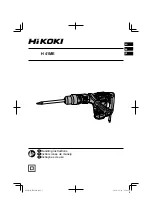
10
| English
1 609 92A 1W8 | (22.6.16)
Bosch Power Tools
Temperature Control/Overload Protection Indicator
The red LED indicator
6
will help you in protecting the battery
against overheating and the motor against overloading.
When the LED indicator
6
continuously lights up red
, the
temperature of the battery is too high and the machine
switches off automatically.
– Switch the power tool off.
– Allow the battery to cool down before continuing to work.
The LED indicator
6
flashes red
, the power tool is blocked
and switches off automatically.
Remove the power tool from the workpiece.
As soon as the blockage is corrected, the power tool will con-
tinue to work at the set stroke rate.
Protection Against Deep Discharging
The lithium ion battery is protected against deep discharging
by the “Electronic Cell Protection (ECP)”. When the battery is
empty, the machine is switched off by means of a protective
circuit: The inserted tool no longer rotates.
Switching on the LED Work Area Illumination
With the button
3
you can switch on the LED work light. The
work light is switched off by default.
Restarting Protection
The restarting protection prevents uncontrolled starting of
the machine after a power failure. Once the restarting protec-
tion is active, the temperature control/overload protection in-
dicator blinks
6
continuously.
To
restart the operation
, switch the On/Off switch
7
to the
Off position and start the machine again.
Note:
When switching off and on again very quickly, it is pos-
sible that the restarting protection is triggered; this will pre-
vent the power tool from starting, although the On/Off switch
7
is actuated. Set the On/Off switch
7
to the off position, and
then switch the power tool on again.
Working Advice
When sawing small or thin workpieces, always use a
firm support.
Contact Protector
The contact protector
19
attached to the casing prevents ac-
cidental touching of the saw blade during the working proce-
dure and may not be removed.
The outwardly curved edge over the extraction hood
16
pre-
vents the hand from slipping away in the sawing range.
Plunge Cutting (see figure G)
Plunge cuts may only be applied to soft materials, such
as wood, gypsum plaster boards, etc.!
Use only short saw blades for plunge cutting. Plunge cutting is
possible only with the mitre angle set at 0°.
Place the machine with the front edge of the base plate 9 on
to the workpiece without the saw blade 14 touching the work-
piece and switch on. For machines with stroke rate control,
select the maximum stroke rate. Firmly hold the machine
against the workpiece and by tilting the machine, slowly
plunge the saw blade into the workpiece.
When the base plate 9 fully lays on the workpiece, continue
sawing along the desired cutting line.
Parallel Guide with Circle Cutter (Accessory)
Parallel Cuts (see figure H): Loosen the locking screw
26
and
slide the scale of the parallel guide through the lead
13
in the
base plate. Set the desired cutting width as the scale value
on the inside edge of the base plate. Tighten the locking
screw
26
.
Circular Cuts (see figure I): Set the locking screw
26
to the
other side of the parallel guide. Slide the scale of the parallel
guide through the lead
13
in the base plate. Drill a hole in the
workpiece centred in the section to be sawn. Insert the cen-
tring tip
28
through the inside opening of the parallel guide
and into the drilled hole. Set the radius as the scale value
on the inside edge of the base plate. Tighten the locking
screw
26
.
Coolant/Lubricant
When sawing metal, coolant/lubricant should be applied
alongside cutting line because of the material heating up.
Maintenance and Service
Maintenance and Cleaning
Before any work on the machine itself (e.g. mainte-
nance, tool change, etc.) as well as during transport
and storage, remove the battery from the power tool.
There is danger of injury when unintentionally actuating
the On/Off switch.
For safe and proper working, always keep the machine
and ventilation slots clean.
Clean the saw blade holder regularly. For this, remove the saw
blade from the machine and lightly tap out the machine on a
level surface.
Heavy contamination of the machine can lead to malfunc-
tions. Therefore, do not saw materials that produce a lot of
dust from below or overhead.
Lubricate the guide roller
10
occasionally with a drop of oil.
Check the guide roller
10
regularly. If worn, it must be re-
placed through an authorised Bosch after-sales service agent.
The plastic sliding shoe
12
should be replaced when it is
worn.
After-sales Service and Application Service
Our after-sales service responds to your questions concern-
ing maintenance and repair of your product as well as spare
parts. Exploded views and information on spare parts can al-
so be found under:
www.bosch-pt.com
Bosch’s application service team will gladly answer questions
concerning our products and their accessories.
In all correspondence and spare parts order, please always in-
clude the 10-digit article number given on the type plate of
the machine.
OBJ_BUCH-2066-003.book Page 10 Wednesday, June 22, 2016 8:21 AM











































